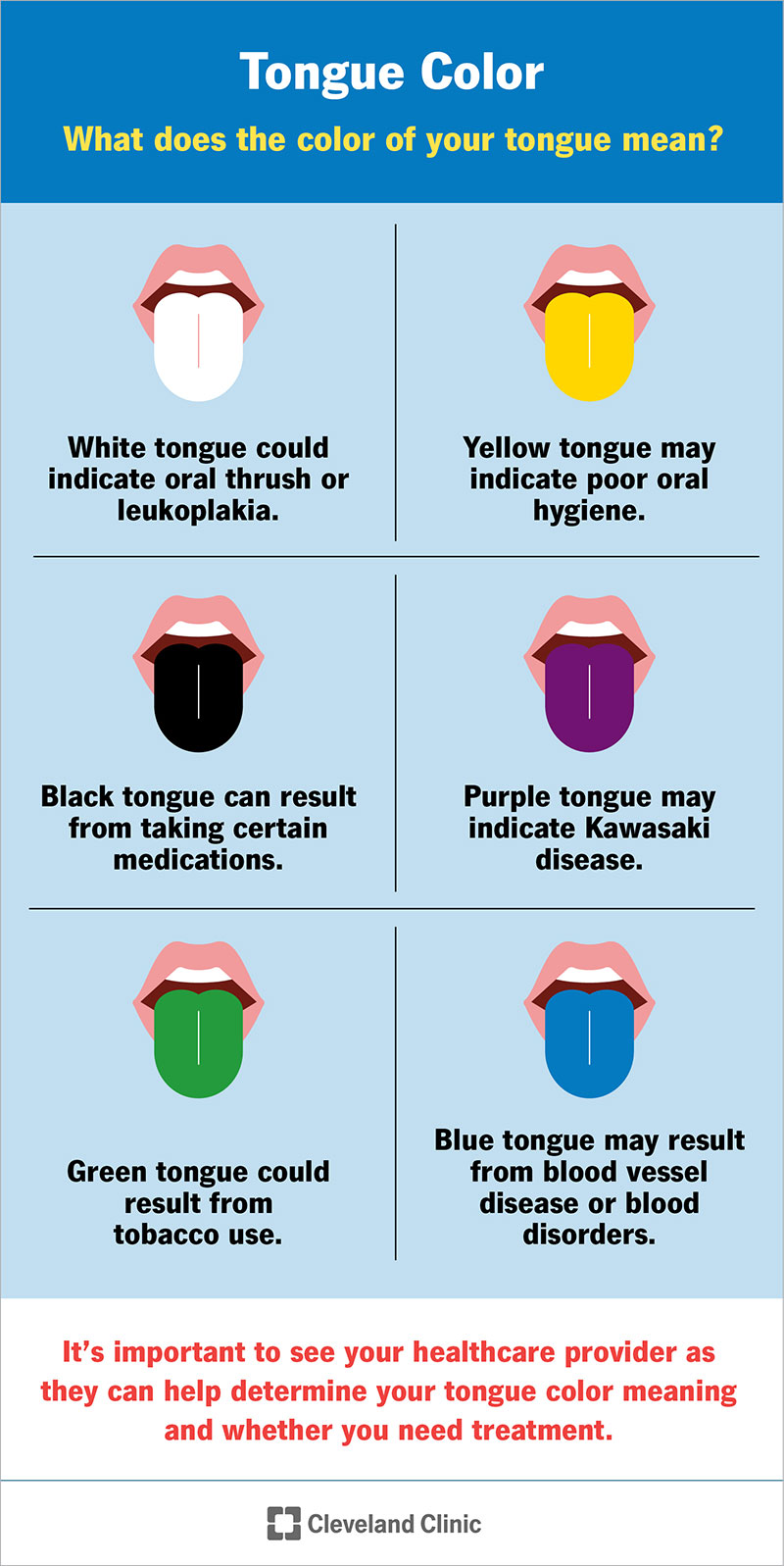Tongue color can tell you a lot about your overall health. A healthy tongue is light to dark pink. But significant color changes may indicate an underlying health condition. Knowing what to look for can help you detect issues early on, so you can get the treatment you need.
Healthy tongue color is pink, though the specific shades may range from light to dark. A healthy, normal-colored tongue also has small bumps all over its surface. These are papillae. They help you speak, taste, chew and swallow.
Any tongue color other than pink could indicate an underlying health condition. You should let a healthcare provider know if your tongue is:
Cleveland Clinic is a non-profit academic medical center. Advertising on our site helps support our mission. We do not endorse non-Cleveland Clinic products or services. Policy

Different tongue colors mean different things — and each color could indicate a wide range of conditions. That’s why it’s important to see a healthcare provider for an evaluation. They can help determine your tongue color meaning and whether you need treatment.
White tongue discoloration may appear in lines, lacey patterns or thick patches. A white tongue could indicate:
Most of the time, a yellow tongue indicates an overgrowth of bacteria. This is usually due to poor oral hygiene.
You can also develop a yellow tongue color if you:
Many of the same factors that cause yellow tongue cause orange tongue, too. The most common cause is poor oral hygiene.
Orange tongue may also result from:
Healthcare providers may refer to a red tongue as a “strawberry tongue.” A tongue that’s bright red may indicate:
Some people with geographic tongue may develop whitish-gray borders around the main red areas.
In addition, a 2017 study found that many people with eczema develop gray or pale tongues.
Your tongue may turn black as a result of keratin buildup. Keratin is a protein found in your hair, skin and nails. Keratin, food particles and debris can cling to the papillae (small bumps) on your tongue, making it appear black and hairy.
Black hairy tongue can result from:
Purple is a less common tongue color. It may indicate:
Similar to yellow tongue, a green tongue often results from a buildup of bacteria. Main causes include:
A blue tongue may indicate cyanosis — a lack of oxygen in your blood. Causes include:
If you have a blue tongue, you should call your healthcare provider right away. Low levels of oxygen in your blood is a serious condition and requires prompt medical attention.
To get rid of tongue discoloration, you’ll need to treat the underlying condition that caused it. For example, if you have white tongue from oral thrush, your provider will likely prescribe antifungal medication. If you have yellow tongue as a drug side effect, your provider may change your medication. If you have black hairy tongue due to poor oral hygiene, your dentist will work with you to improve brushing and flossing techniques.
No matter your tongue color, your provider can work with you to determine the underlying cause and design a personalized treatment plan.
Tongue discoloration isn’t always preventable, especially if it’s a symptom of an underlying health condition. But you can reduce your risk of tongue discoloration by following these guidelines:
If you have tongue discoloration that lingers or doesn’t get better with improved oral hygiene, schedule an appointment with a healthcare provider. They can determine if you have an underlying condition and talk with you about your treatment options.
If you have a blue tongue, call your healthcare provider right away. It could indicate a lack of oxygen in your blood.
A discolored tongue doesn’t mean you have a dirty tongue. But a tongue that’s yellow, green or black could mean you have a buildup of bacteria. To fix this issue, try improving your oral hygiene: Brush and floss your teeth daily, and don’t forget to clean your tongue.
If you’re dehydrated, your tongue will probably look dry. It will also have a yellowish or whitish coating.
If your tongue constantly sticks to the roof of your mouth, you’re probably dehydrated. To avoid this issue, drink plenty of water.
A note from Cleveland Clinic
A healthy tongue is pink in color. If your tongue color is white, yellow, orange, red, black, purple, gray, green or blue, it could mean you have an underlying health condition. If you have tongue discoloration that doesn’t go away, tell your healthcare provider. They can help determine the best course of action.
Last reviewed by a Cleveland Clinic medical professional on 01/13/2023.
Learn more about our editorial process.
Cleveland Clinic is a non-profit academic medical center. Advertising on our site helps support our mission. We do not endorse non-Cleveland Clinic products or services. Policy